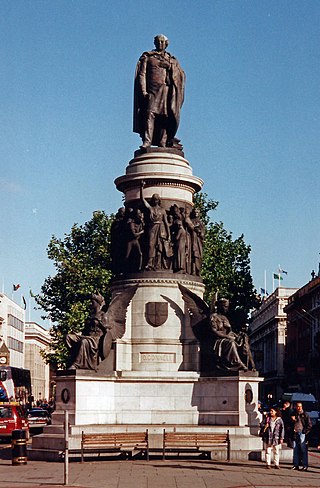
O'Connell Street is a street in the centre of Dublin, Ireland, running north from the River Liffey. It connects the O'Connell Bridge to the south with Parnell Street to the north and is roughly split into two sections bisected by Henry Street. The Luas tram system runs along the street.

The City Hall, Dublin, originally the Royal Exchange, is a civic building in Dublin, Ireland. It was built between 1769 and 1779, to the designs of architect Thomas Cooley, and is a notable example of 18th-century architecture in the city. Originally used by the merchants of the city, it is today the formal seat of Dublin City Council.

St Mary's Church, known also as St Mary's Pro-Cathedral or simply the Pro-Cathedral, the Chapel in Marlborough Street or the Pro, is a pro-cathedral and is the episcopal seat of the Catholic Archbishop of Dublin and Primate of Ireland.

Parliament House in Dublin, Ireland, was home to the Parliament of Ireland, and since 1803 has housed the Bank of Ireland. It was the world's first purpose-built bicameral parliament house. It is located at College Green.
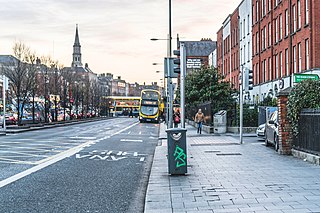
Dorset Street is an important thoroughfare on the north side of Dublin, Ireland, and was originally part of the Slighe Midh-Luchra, Dublin's ancient road to the north that begins where the original bridging point at Church Street is today. Subsequently, yet prior to the street being given its current name in the 18th century, the road was known as Drumcondra Lane and was shown on maps as such. It is divided into Dorset Street Lower and Dorset Street Upper.
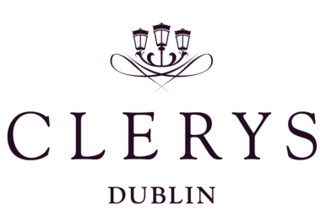
Clerys was a long-established department store on O'Connell Street in Dublin, Ireland, a focal point of the street. The business dates from 1853, however the current building dates from 1922, the original having been completely destroyed in the 1916 Easter Rising. Clerys completed a five-year restoration programme in 2004 at a cost of €24 million but went into receivership in 2012, and was sold. Under American ownership, it abruptly closed in 2015, and issues arose with staff and franchise holders over an extended period afterwards.

The Dublin and South Eastern Railway (DSER), often referred to as the Slow and Easy, was an Irish gauge railway in Ireland from 1846 to 1925. It carried 4,626,226 passengers in 1911. It was the fourth largest railway operation in Ireland operating a main line from Dublin to Wexford, with branch lines to Shillelagh and Waterford. The company previously traded under the names Waterford, Wexford, Wicklow & Dublin Railway to 1848, Dublin and Wicklow Railway (D&WR) to 1860 and Dublin, Wicklow and Wexford Railway (DW&WR) until 1906.

Dún Laoghaire Mallin railway station is a station in Dún Laoghaire, Dún Laoghaire–Rathdown, Ireland.
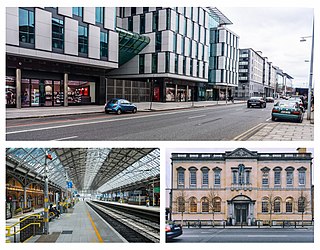
Pearse Street is a major street in Dublin. It runs from College Street in the west to MacMahon Bridge in the east, and is one of the city's longest streets. It has several different types of residential and commercial property along its length.

Cathal Brugha Street is a street on the northside of Dublin, Ireland.

Nelson's Pillar was a large granite column capped by a statue of Horatio Nelson, built in the centre of what was then Sackville Street in Dublin, Ireland. Completed in 1809 when Ireland was part of the United Kingdom, it survived until March 1966, when it was severely damaged by explosives planted by Irish republicans. Its remnants were later destroyed by the Irish Army.
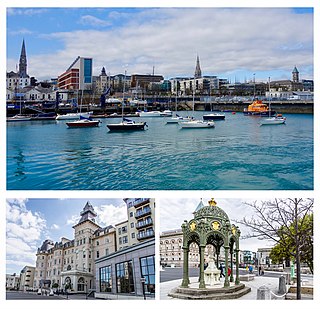
Dún Laoghaire is a suburban coastal town in County Dublin in Ireland. It is the administrative centre of the county of Dún Laoghaire–Rathdown. The town was built up alongside a small existing settlement following 1816 legislation that allowed the building of a major port to serve Dublin. It was known as Dunleary until it was renamed Kingstown in honour of King George IV's 1821 visit, and in 1920 was given its present name, the original Irish form from which "Dunleary" was anglicised. Over time, the town became a residential location, a seaside resort, the terminus of Ireland's first railway and the administrative centre of the former borough of Dún Laoghaire, and from 1994, of the county of Dún Laoghaire–Rathdown.

Newtown Pery is an area of central Limerick, Ireland, and forms the main city centre of the city. The district is known for its Georgian architectural heritage and is the core area of Limerick's Georgian Quarter. It is one of the three towns that make up modern-day Limerick City Centre, the other two being the older Englishtown and Irishtown, which date from the medieval period. Newtown Pery houses the largest collection of Georgian townhouses in Ireland outside of Dublin. In 1837, Samuel Lewis in his Topographical Dictionary of Ireland described Newtown Pery as "one of the handsomest towns in Ireland".
The following is a timeline of events pertaining to the Troubles in Dublin, Republic of Ireland.

Cathedral Street is a street in central Dublin, Ireland, formerly known as Elephant Lane and Tyrone Place.

The Imperial Hotel was a hotel in Dublin's principal thoroughfare, Sackville Street, until it was destroyed during the Easter Rising of 1916. The building comprised Clerys department store on the lower floors and the Imperial Hotel on upper floors situated opposite the General Post Office and Nelson's Pillar.
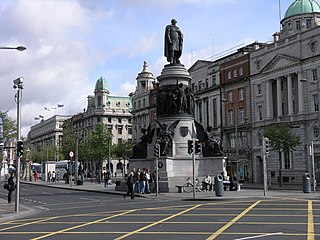
The O'Connell Monument is a 40 ft high commemorative granite and bronze monument honouring nationalist leader Daniel O'Connell (1775–1847) located on O'Connell Street, the main thoroughfare of Dublin, Ireland.
Golden Hill quarry, is a former granite quarry on Golden Hill, adjacent to the village of Manor Kilbride, County Wicklow, Ireland. Its exact coordinates are unknown.

The Barnacullia quarries are a number of former, and current, granite quarries in the townland of Barnacullia on the north-eastern slopes of Three Rock Mountain in the county of Dún Laoghaire–Rathdown, Ireland. According to a Historic Landscape Character Assessment (HLCA) conducted in 2006, the area was at one point "an important source of granite for the buildings of nearby Dublin".

Ballyknockan quarry, or more correctly Ballyknockan quarries, are a collection of disused granite quarries in the village of Ballyknockan, County Wicklow, Ireland. From the early 19th century onward, the site was "probably the most important area for supplying cut stone blocks of granite for the construction of many of Dublin city's major public buildings", according to a report by the Geological Survey of Ireland. At its height, from approximately the 1840s to 1870s, there would have been "hundreds of workers" active in various trades in the quarries, which lie some 15 miles south-west of Dublin city. Transportation of the materials alone to the city by horse and cart required considerable logistical effort.




















